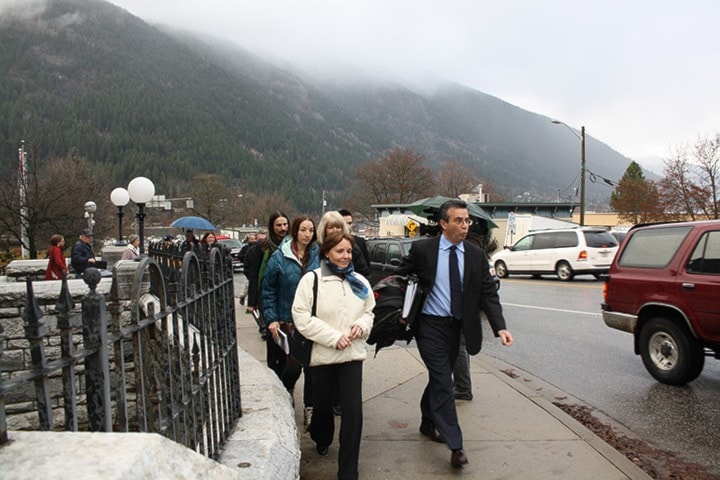A Nelson coroner’s jury has made nine recommendations to prevent future deaths like that of a Nelson Search and Rescue volunteer.
The suggestions are all directed at Emergency Management BC and the BC Search and Rescue Association and include standardized training and equipment for swift water teams, and a review of funding models to better support operations.
The jury also calls for an audit of search and rescue groups in BC to ensure each is properly equipped, and the development of a standardized risk assessment tool for swift water operations.
Sheilah Sweatman drowned in the Goat River near Creston on June 29, 2011 while attempting to recover a submerged vehicle. Her leg got caught on a steel cable and she was pulled into the water and drowned.
The jury heard five lengthy days of testimony from about 20 witnesses this week before beginning their deliberations this morning. They reached their verdict late this afternoon.
Sweatman’s father Wynn told reporters the jury was thorough and his family is happy to have the recommendations.

“I feel like we can now begin to move forward,” he said. “But it’s been a really hard week. From an emotional point of view, we’ve taken a step back a year in terms of coping with this loss.”
Although the recommendations don’t specifically mention the use of steel cable in vehicle recoveries, Wynn said they do suggest that swift water teams use only their own equipment whenever possible. The jury also said appropriate tools for self-rescue and companion rescue “must be immediately accessible.”
“In one way or another, all of those things contributed to losing Sheilah,” Wynn said. “There’s nothing happy about this for us, but I think Sheilah’s legacy will be a big improvement in standards.”
Wynn was the last witness to testify Friday. He said no facts emerged at the inquest that weren’t previously learned in the 16 months since Sheilah’s death.
“It made me mad it took so long to get to those issues that ultimately end up fairly simple. I told them Sheilah was courageous and passionate and that the managers and the system needs to protect the passionate volunteers.”
He added the family has no interest in pursuing civil action in the case.
BC Search and Rescue Association president Don Bindon, who attended the inquest, said his members are “extremely grateful” for the jury’s work.
“These nine recommendations give us an excellent road map ... We’re going to do our very best to implement each and every one of them.”
Bindon says they have not been waiting for the inquest to make changes — plans are already afoot to standardize swift water training. Although the jury did not make any specific recommendations around vehicle recoveries, Bindon said they are looking at ways to reduce the hazards of such operations.
The recommendations didn’t mention the use of video cameras in search exercises either — the tragic operation was caught on tape as part of filming for the reality TV show Callout: Search and Rescue, and the jury viewed the footage — but Bindon said he doesn’t think it was a factor.
“Absolutely not ... If I believed the video played a role, we would be making some very serious adjustments,” he said.
Presiding coroner Matt Brown thanked the jury for a “difficult” six days and Sweatman’s family for their “will and determination and reminder of why we are here.”
The non-binding recommendations are provided to the chief coroner and then distributed to the groups named. “In the spirit of the inquest, and Sheilah’s passing, we hope they are followed through,” Brown said.
The jury’s recommendations
1. That Emergency Management British Columbia expand the existing swift water task force to include members of search and rescue operations as well as the RCMP, BC River Guides Association, BC River Outfitters Association, WorkSafe BC and any other appropriate stakeholders.
2. That Emergency Management BC and British Columbia Search and Rescue Association develop universal standards for swift water rescue and recovery training to ensure consistent language and training applications. These universal standards would require all swift water training providers to conform to these prescribed standards.
3. That Emergency Management BC and BC Search and Rescue Association develop universal standards for swift water rescue and recovery equipment.
4. That an audit be conducted of all search and rescue communities by BC Search and Rescue Association to ensure that each search and rescue community has the required equipment (including personal protective equipment) and training for their respective communities based on their unique areas. Where it is determined that there is a lack of the required equipment and/or training for that area, immediate consultation with BC Search and Rescue Association and Emergency Management BC must occur to determine steps to obtain the equipment and/or training with the goal of safety of all search and rescue members in BC.
5. That Emergency Management BC review and evaluate funding models to better support search and rescue operations, training and equipment similar to Volunteer Fire Departments/ funding.
6. That swift water teams use only their own equipment during search and rescue operations whenever possible. If any unfamiliar equipment is introduced into a task, a proper risk assessment must be completed. The appropriate tools for self rescue and companion rescue must be immediately accessible.
7. That the volunteer policy and procedures manual specifically the policy for “Utilization of volunteers for search and rescue activities policy” be reviewed by Emergency Management BC to clarify and amend, where required, the roles and responsibilities of varying agencies involved in search and rescue activities. These groups include, but are not limited to search and rescue, policing agencies, coroner, Parks Canada, BC Ambulance and fire services.
8. That during an operation, a specific safety officer be designated whenever possible. This safety officer(s) position will be their sole function.
9. That Emergency Management BC with the assistance of the search and rescue stakeholders develop a standardized risk assessment tool for use in swift water operations.
